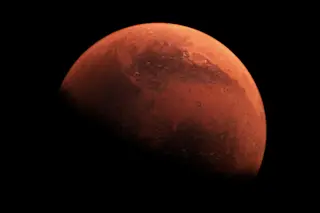This is the fifteenth in a series of reports from the HI-SEAS simulated Mars mission. Read others in the series here.

Crewmember Yajaira Sierra-Sastre receiving a dose of morning light. Credit: Sian Proctor There are less than two weeks left in the mission, and sleep is still at a premium. Many of us net less than seven hours a night, constantly trying to pay off sleep debt. I should know better than anyone: my research here investigates the quality and quantity of HI-SEAS crewmember sleep---or, evidently, the lack thereof. Sleep is an intimate part of our lives, and the crew has been generous enough to donate data on theirs to help me answer some questions. Simply put, I wanted to know how a 45-minute dose of morning light affects crewmembers’ sleep the subsequent night. Will it help them fall asleep faster? Will it increase time spent in REM or deep sleep? Will they feel more rested overall?
Sleep in Space
It’s well known that astronauts sleep poorly in space. Sleep aids make up a large fraction of medications taken during the shuttle missions and on the International Space Station. Despite this, according to a 2009 study, over half of astronauts don’t get more than 6 hours of sleep a night. Lack of sleep leads to cognitive problems, slower reaction times, and physical and psychological stress. A majority of the six Mars500 crew who simulated a 17-month Mars journey experienced serious sleep problems. On a real three-year Mars mission, lack of sleep could be lethal. That’s why sleep is on the list of problems that NASA knows it needs to solve for long-term space exploration to be feasible.
Need for Natural Light
Many factors cause restless nights, but one major contributor seems to be the lack of natural lighting. Daylight is rich in blue wavelengths that act as a sort of "wake up" trigger to the brain. In fact, studies have demonstrated that when we’re exposed to bright, blue-white light in the evenings, the release of the sleep hormone melatonin is delayed. It could be one reason it’s hard go to sleep after staring at a computer screen or television late at night. I knew there’d be little natural light in our habitat, therefore HI-SEAS seemed like a great opportunity for a sleep and light experiment. To design the study, I reached out to George “Bud” Brainard of Thomas Jefferson University in Philadelphia, Pennsylvania. Brainard is a well-known sleep and lighting who, as it happened, was working with NASA to replace the fluorescent ISS lighting with LEDs when I contacted him. Brainard and other researchers believe that the new space station lights can help astronauts sleep better. The improvement would come by using four modes: bright blue-white light in the morning; less-bright, white light during the day; dim, red-shifted light in the evening; and completely dark at night.
Sleep Study
My proposed HI-SEAS study happened to fit nicely with both Brainard’s and NASA’s goals for helping astronauts sleep better. One of my main objectives for the experiment was to keep it as simple as possible. The only independent variable would be a 45-minute dose of bright morning light. I scheduled four two-week cycles of bright morning light, alternated with two weeks of no morning light. For the dose, we used a product called Litebook, made by a Canadian company of the same name. (Litebook, which has been validated as a treatment for seasonal affective disorder, donated units to the cause.) Sleep quality and feelings of sleepiness would be measured by three short daily surveys as well as by the Zeo sleep monitoring system. The Zeo is a wireless-sensor headband that picks up electrical signals from the brain, like an EEG does, and from muscle activity from the face and eyes. It transmits this data to a bedside unit that doubles as an alarm clock. Zeo's proprietary algorithms interpret the data and infer time spent in four sleep stages---REM, light sleep, deep sleep and wakefulness---which are the measures I’m particularly interested in. (Zeo, a startup out of Massachusetts, which also donated units to the study, was unfortunately dissolved earlier this year.) In addition to surveys and sleep-monitoring headbands, I’ve also asked the crew to donate a few samples of saliva just before bed to be tested for melatonin concentrations.
Messy Data
One of the trickiest parts of the study for me---aside from conducting it at all, as I am a professional writer with a background in laser physics and not in human-subject research---has been to accept the fact that this is not a controlled laboratory experiment. HI-SEAS is what is known as an operational environment. By its nature, the data collected here is messy. It will require numerous correction factors. And the results will need to be taken within the context of Mars analog experiments. My hope is that I’ve gathered enough data---four months' worth---to be able to pull out some clear conclusions, something that could help inform future experiments or answer open questions. The crew is currently undergoing our last cycle of morning light exposure. After the mission I begin my long journey into corrections and analysis. It’s impossible at this point for me to say if the light is helping anyone sleep better. I do know from crewmate conversations, however, that a good night’s sleep has been elusive for most of us at various points in the mission, for reasons including research obligations, restlessness, and health concerns. To be fair, it’s not bad as it could be. And it’s only been four months. But years of sleep deprivation can take its toll on anyone, including intrepid Martian explorers.













